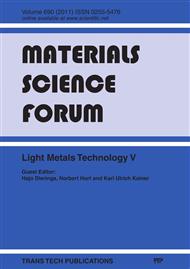p.290
p.294
p.298
p.302
p.306
p.311
p.315
p.319
p.323
Effects of Ceramic Inoculants and Intermetallic Phases on Hot Rolled AZ Magnesium Wrought Alloys
Abstract:
The role of ceramic particles, calcium and rare earth elements on magnesium alloys during solidification from the melt and after hot rolling has been studied by microstructural investigations, texture measurements and mechanical tests. Different ceramic inoculants like silicon carbide or zirconium diboride and two different rare earth elements (cerium and lanthanum) forming intermetallic compounds were used. Both, ceramic particles and intermetallic phases, modify the texture evolution during hot forming. The rolled alloys exhibited a basal fibre texture which is weakened by ceramic particles and intermetallic phases respectively. This weakening of the basal texture is capable of lowering the anisotropy of the yield stress and improving the formability of sheet material. Influences of the alloying contents on microstructure, texture evolution and mechanical properties will be discussed.
Info:
Periodical:
Pages:
306-310
Citation:
Online since:
June 2011
Keywords:
Price:
Сopyright:
© 2011 Trans Tech Publications Ltd. All Rights Reserved
Share:
Citation:


